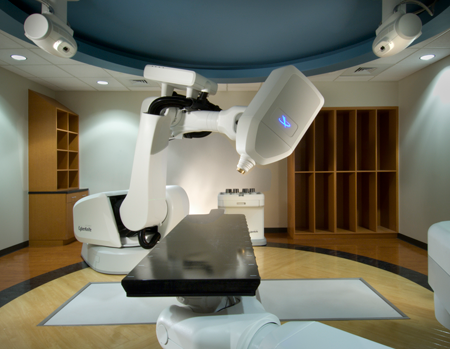

Virginia Hospital Center’s new CyberKnife® Robotic Radiotherapy System treats inoperable tumors anywhere in the body with sub-millimeter accuracy. Virginia Hospital Center is the only local facility to augment CyberKnife with two enhancements:
- The RoboCouch® Patient Positioning System reproduces alignment of patients with unprecedented accuracy, streamlining setup and treatment processes.
- The XChange™ Robotic Collimator Changer switches collimator sizes automatically during treatments, minimizing patient movement while increasing efficiency.
What is the CyberKnife® Robotic Radiotherapy System?
- Non-invasive, painless radiation treatment designed to treat tumors almost anywhere in the body with sub-millimeter accuracy.
- Delivers a high dose of radiation to tumors with extreme accuracy. Hundreds of beams enter the body at different locations and through different angles. The highest dose of radiation develops where the beams intersect at the region to be treated.
- Can be an alternative to open surgery in many cases.
- Uses image guidance technology and computer controlled robotics.
- Continuously track the tumor, detect its location and correct for tumor and patient movement in real-time throughout the treatment.
- Does not require invasive head or body frames to stabilize patient movement.
- Outpatient procedure. There are no incisions, no pain, no blood, no stereotactic frame (as used with the Gamma Knife ™), no anesthesia and limited recovery time.
- Patients can return to normal activity immediately after treatment.
How does it differ from traditional external radiation?
- Shorter treatment time – usually 1-5 treatments vs. 6-8 weeks of treatment with conventional radiation therapy.
- Less damage to healthy tissues and critical structures due to the precise targeting and fractionated doses (large doses spread out over several treatments).
- Generally fewer side-effects than traditional radiation.
What are the side-effects?
- Depending on the area being treated, side effects could include fatigue, nausea, mild skin reactions, some hair loss, sore throat, headache, and urinary and bowel problems.
Does my Insurance cover CyberKnife® treatments?
- Individual insurance plans vary and most currently cover CyberKnife treatments. We can help you determine your insurance coverage and answer any financial questions you have.
How long does the treatment take?
- Treatment time varies depending on the location of the tumor and the complexity of the treatment plan. Treatment times are generally between 30 minutes and 2 hours.
How many treatments do I have to have?
- Treatments are 1 to 5 sessions on consecutive business days.
What is involved with my treatment plan?
- Your radiation oncologist, physicist and your surgeon, pulmonologist or other physician.
- You will also be cared for by a team including the CyberKnife Coordinator/RN, radiation therapists and other radiation oncology and hospital staff members including the CT Scan and MRI technicians.
Do I have to have tests or procedures before I can start treatment?
- Yes. All patients have a CT Scan specifically for CyberKnife treatment planning purposes. Patients may also require a CyberKnife treatment treatment planning MRI.
- Some patients require fiducials (small metal markers) placed in or near their tumor on an outpatient basis 2-3 weeks before treatments can begin.
- All patients will see a registered nurse (RN) before and after each treatment. The RN will review any pre or post-treatment specifics such as medications or diet modifications with each patient.
- A Registered Nurse is available to answer questions about tests, treatments, and side-effects at any time.
Do I have to wear a mask?
- Brain, head and neck lesions require a custom mask to be fitted for each patient.
- For most body tumors, a body cradling mold is used to help the patient maintain the same position during each treatment session.
How does CyberKnife® account for tumors that move with breathing?
- The Synchrony® Respiratory Tracking System allows patients to breathe normally throughout their treatment.
- The robotic system is able to track, detect and correct for tumor and patient movement throughout the treatment, thus minimizing damage to surrounding healthy tissue and critical structures.
How many patients has Virginia Hospital Center treated?
- We started treating patients in February of 2008. We have completed over 150 treatments as of August 2008.
Have treatments been successful?
- Yes. Since 1999, more than 50,000* patients have been treated with the CyberKnife® System throughout the world. Over 290 technical and clinical publications have documented its efficacy.
*as of June 2008
Link to Accuray Virtual Press Kit
